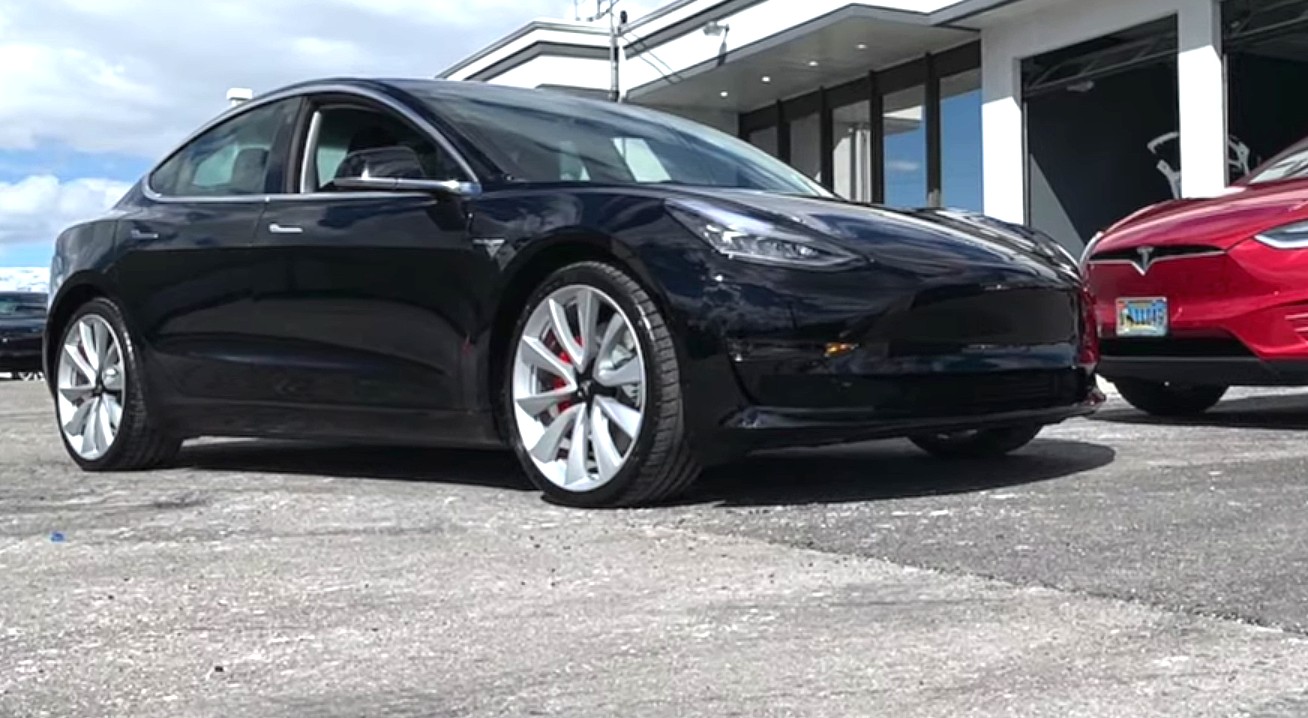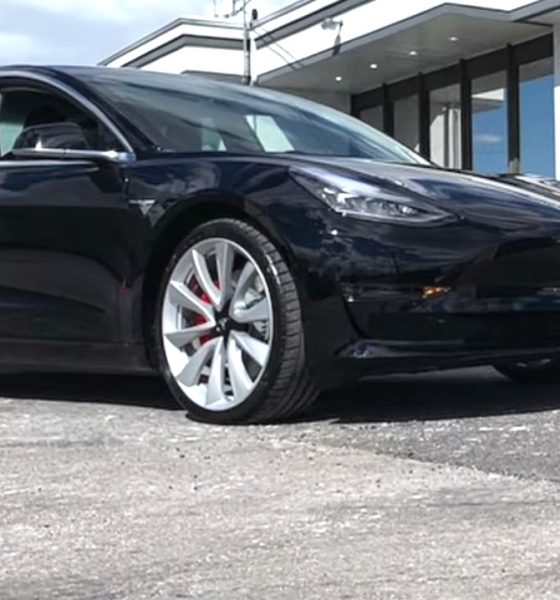

News
Tesla Model 3 Performance endures 31 hard launches with no throttling
The Tesla Model 3 could be considered as the electric car maker’s endurance champion in its current lineup. Not quite as quick as a Model S or Model X Performance in Ludicrous Plus Mode but capable of being driven hard for extended periods in a racetrack, the Model 3 Performance is a vehicle that has charmed even the staunchest gearheads of motoring media. Top Gear host Chris Harris, for one, described the Model 3 Performance as an “AK-47 disguised as a butter knife” during his review of the vehicle, which he found to be too plain in design compared to comparable ICE cars like the BMW M3. It should be noted that after his review, Harris noted on Twitter that he will be buying a Model 3 Performance for himself soon.
The Model 3’s endurance, both on the track and the highway, has been tested and proven by professionals and enthusiasts alike. Tesla and electric vehicle veteran Bjorn Nyland tested the Model 3 in the Autobahn last June, going flat at full speed in an attempt to overheat the car. He failed. The same is true for other reviewers such as Harris, who pitted the Model 3 Performance against the BMW M3-beating Alfa Romeo Giulia Quadrifoglio in a time attack battle. True to Elon Musk’s statements on Twitter, the Model 3 Performance, thanks to its instant torque that allows the vehicle to launch from 0-60 mph in 3.2 seconds, soundly beat the Giulia Q4 in a closed circuit.
Last week, Porsche made headlines when the company allowed Fifth Gear and Fully Charged host Jonny Smith to take one of its Taycan Turbo pre-production vehicles for a launch mode repeatability test. Conducted on an empty airfield, the test involved the EV veteran launching the Taycan Turbo at max power 26 times with no power throttling. The exhibition was impressive, and it invoked just how much work Porsche has put into the Taycan and its development. The Taycan’s feat also brought comparisons to Tesla’s Model S P100D, which was quicker off the line with its 0-60 mph time of 2.4 seconds, but is prone to limiting its power after multiple max power launches.
After watching the Taycan’s demonstration, Tesla owner Patrick Lawson opted to see if his vehicle, a Tesla Model 3 Performance, could accomplish multiple max power launches without losing power as well. Accompanied by his son, Lawson headed to a (mostly) empty stretch of road to test the endurance of his Model 3. In a message to Teslarati, the Tesla owner noted that with Track Mode on, he figured that his vehicle should be able to perform comparably to the Taycan.
By the 10th 0-60 mph test, Lawson noted that he was already feeling the effects of the Model 3’s multiple hard launches. The father and son duo continued over the next 30 minutes, hitting 31 consecutive launches in the Model 3. At that point, Lawson noted that his son was probably good for about 10 more launches, but that was about all he could handle. Interestingly, the Model 3 Performance, just like the Porsche Taycan Turbo, did not throttle its power at all. The 31st launch registered a 0-60 mph time of 3.11 seconds, which is in the same territory as the Taycan Turbo.
Granted, Lawson’s test did not involve the same parameters as Fully Charged’s test of Porsche’s all-electric car. The Taycan Turbo, for one, performed 26 runs that topped up at speeds of 200 kph (124 mph), while Lawson’s Model 3 Performance test only involved 31 0-60/0-70 mph runs. Nevertheless, it should be noted that the Tesla owner’s tests were conducted on a public road in the United States, which usually have speed limits of around 60-70 mph.
The Tesla Model 3 could be considered, in more ways than one, as a Trojan Horse of sorts. While the vehicle is considered as the “cheaper” Tesla (and this is accurate, of course), and while the vehicle experienced a notable period of anti-selling by the company, the electric car has been showing signs that there is more to it than meets the eye. With track capability and a price point that is notably more affordable than other premium EVs in the market, the Model 3 will likely be the vehicle that ultimately brings electric cars into the mainstream.
Watch Partick Lawson and his son’s Tesla Model 3 Performance 31-launch endurance test in the video below.

News
Tesla FSD fleet is nearing 7 billion total miles, including 2.5 billion city miles
As can be seen on Tesla’s official FSD webpage, vehicles equipped with the system have now navigated over 6.99 billion miles.

Tesla’s Full Self-Driving (Supervised) fleet is closing in on almost 7 billion total miles driven, as per data posted by the company on its official FSD webpage.
These figures hint at the massive scale of data fueling Tesla’s rapid FSD improvements, which have been quite notable as of late.
FSD mileage milestones
As can be seen on Tesla’s official FSD webpage, vehicles equipped with the system have now navigated over 6.99 billion miles. Tesla owner and avid FSD tester Whole Mars Catalog also shared a screenshot indicating that from the nearly 7 billion miles traveled by the FSD fleet, more than 2.5 billion miles were driven inside cities.
City miles are particularly valuable for complex urban scenarios like unprotected turns, pedestrian interactions, and traffic lights. This is also the difference-maker for FSD, as only complex solutions, such as Waymo’s self-driving taxis, operate similarly on inner-city streets. And even then, incidents such as the San Francisco blackouts have proven challenging for sensor-rich vehicles like Waymos.
Tesla’s data edge
Tesla has a number of advantages in the autonomous vehicle sector, one of which is the size of its fleet and the number of vehicles training FSD on real-world roads. Tesla’s nearly 7 billion FSD miles then allow the company to roll out updates that make its vehicles behave like they are being driven by experienced drivers, even if they are operating on their own.
So notable are Tesla’s improvements to FSD that NVIDIA Director of Robotics Jim Fan, after experiencing FSD v14, noted that the system is the first AI that passes what he described as a “Physical Turing Test.”
“Despite knowing exactly how robot learning works, I still find it magical watching the steering wheel turn by itself. First it feels surreal, next it becomes routine. Then, like the smartphone, taking it away actively hurts. This is how humanity gets rewired and glued to god-like technologies,” Fan wrote in a post on X.
News
Tesla starts showing how FSD will change lives in Europe
Local officials tested the system on narrow country roads and were impressed by FSD’s smooth, human-like driving, with some calling the service a game-changer for everyday life in areas that are far from urban centers.

Tesla has launched Europe’s first public shuttle service using Full Self-Driving (Supervised) in the rural Eifelkreis Bitburg-Prüm region of Germany, demonstrating how the technology can restore independence and mobility for people who struggle with limited transport options.
Local officials tested the system on narrow country roads and were impressed by FSD’s smooth, human-like driving, with some calling the service a game-changer for everyday life in areas that are far from urban centers.
Officials see real impact on rural residents
Arzfeld Mayor Johannes Kuhl and District Administrator Andreas Kruppert personally tested the Tesla shuttle service. This allowed them to see just how well FSD navigated winding lanes and rural roads confidently. Kruppert said, “Autonomous driving sounds like science fiction to many, but we simply see here that it works totally well in rural regions too.” Kuhl, for his part, also noted that FSD “feels like a very experienced driver.”
The pilot complements the area’s “Citizen Bus” program, which provides on-demand rides for elderly residents who can no longer drive themselves. Tesla Europe shared a video of a demonstration of the service, highlighting how FSD gives people their freedom back, even in places where public transport is not as prevalent.
What the Ministry for Economic Affairs and Transport says
Rhineland-Palatinate’s Minister Daniela Schmitt supported the project, praising the collaboration that made this “first of its kind in Europe” possible. As per the ministry, the rural rollout for the service shows FSD’s potential beyond major cities, and it delivers tangible benefits like grocery runs, doctor visits, and social connections for isolated residents.
“Reliable and flexible mobility is especially vital in rural areas. With the launch of a shuttle service using self-driving vehicles (FSD supervised) by Tesla in the Eifelkreis Bitburg-Prüm, an innovative pilot project is now getting underway that complements local community bus services. It is the first project of its kind in Europe.
“The result is a real gain for rural mobility: greater accessibility, more flexibility and tangible benefits for everyday life. A strong signal for innovation, cooperation and future-oriented mobility beyond urban centers,” the ministry wrote in a LinkedIn post.
News
Tesla China quietly posts Robotaxi-related job listing
Tesla China is currently seeking a Low Voltage Electrical Engineer to work on circuit board design for the company’s autonomous vehicles.

Tesla has posted a new job listing in Shanghai explicitly tied to its Robotaxi program, fueling speculation that the company is preparing to launch its dedicated autonomous ride-hailing service in China.
As noted in the listing, Tesla China is currently seeking a Low Voltage Electrical Engineer to work on circuit board design for the company’s autonomous vehicles.
Robotaxi-specific role
The listing, which was shared on social media platform X by industry watcher @tslaming, suggested that Tesla China is looking to fill the role urgently. The job listing itself specifically mentions that the person hired for the role will be working on the Low Voltage Hardware team, which would design the circuit boards that would serve as the nervous system of the Robotaxi.
Key tasks for the role, as indicated in the job listing, include collaboration with PCB layout, firmware, mechanical, program management, and validation teams, among other responsibilities. The role is based in Shanghai.
China Robotaxi launch
China represents a massive potential market for robotaxis, with its dense urban centers and supportive policies in select cities. Tesla has limited permission to roll out FSD in the country, though despite this, its vehicles have been hailed as among the best in the market when it comes to autonomous features. So far, at least, it appears that China supports Tesla’s FSD and Robotaxi rollout.
This was hinted at in November, when Tesla brought the Cybercab to the 8th China International Import Expo (CIIE) in Shanghai, marking the first time that the autonomous two-seater was brought to the Asia-Pacific region. The vehicle, despite not having a release date in China, received a significant amount of interest among the event’s attendees.








